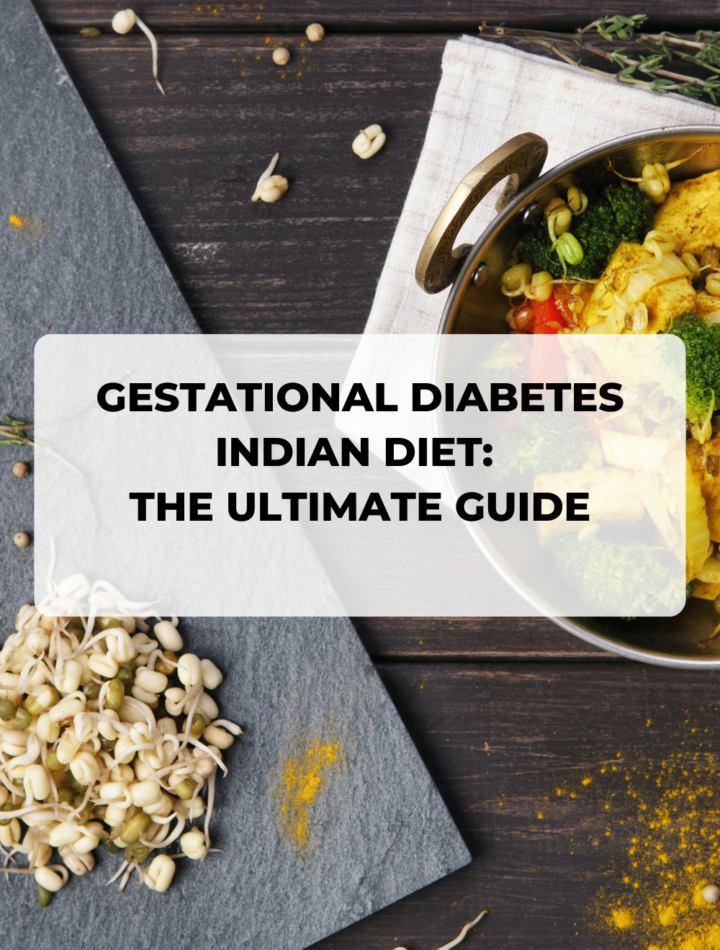So you’re a pregnant woman with gestational diabetes struggling to find recipes, while still being able to indulge in your classic Indian dishes and satisfy your sugar cravings? I totally understand your dilemma. But don’t worry, I’ve got your back! I know it can be challenging for pregnant women with gestational diabetes to find delicious and healthy meals that are in line with managing their blood sugar levels. But with a little guidance, diabetics can enjoy a variety of tasty dishes while following a diabetic diet for pregnancy in an Indian context and keeping their glycemic index under control.
When I was diagnosed with gestational diabetes during my pregnancy, I faced the challenge of finding suitable options for my Indian food needs. It was important for me to make the necessary changes in my diet to ensure a healthy pregnancy for both me and my baby. I was determined to find a gestational diabetes meal plan that would help me manage my condition effectively. By modifying my Indian food choices, I was able to maintain stable blood sugar levels throughout my pregnancy, reducing the risk of complications during birth. It was a personal journey of discovering and adapting Indian dishes that would not only satisfy my cravings but also keep my blood sugar levels in check.
I started my day with vegetable upma, a low-sugar dish packed with colorful veggies. It provided me with essential vitamins and minerals. For lunch, I had dal with brown rice and mixed vegetable curry, which gave me protein, carbohydrates, and vitamins. As a snack, I had roasted chickpeas or nuts to regulate my blood sugar levels. Dinner consisted of chicken curry with roti or quinoa, providing lean protein and healthy carbohydrates. Throughout the day, I included plenty of fresh fruits and vegetables for added nutrients.
The key to maintaining a healthy diet is to strike the right balance between carbs, proteins, and fats while practicing portion control. This is especially important for those following a diabetic diet. Include complex carbohydrates like whole grains, lentils, and vegetables, which provide a steady release of energy and help maintain stable blood sugar levels. Opt for lean sources of protein such as chicken, fish, tofu, and paneer, as they are low in fat and can contribute to healthy fetal development. Don’t forget to include healthy fats from sources like nuts, seeds, and avocados in your gestational diabetes diet and gestational diabetes meal plan, as they are essential for your baby’s brain development and birth. Additionally, make sure to manage your carb intake.
Making these dietary changes was not always easy, but it was definitely worth it. Now that we have discussed the importance of following a diet for gestational diabetes, let’s dive into some specific recipes that are not only suitable for managing this condition but also delicious and satisfying. These recipes have been carefully selected to provide you with the necessary nutrients while keeping your blood sugar levels stable. So, get ready to tantalize your taste buds with a variety of flavorful dishes that will help you maintain a healthy pregnancy.
Table of Contents
-
Key Foods to Include in an Indian Diet for Gestational Diabetes
-
Managing Portion Sizes and Timing of Meals for Gestational Diabetes
-
Importance of Following a Healthy Indian Diet for Gestational Diabetes
Sample Meal Plan for Managing Gestational Diabetes in India
-
A gestational diabetes Indian diet plan should consist of balanced portions of whole grains, lean proteins, healthy fats, and plenty of vegetables.
-
To maintain steady blood sugar levels, it is important to spread meals throughout the day.
-
Incorporating snacks between meals can help prevent hunger and stabilize glucose levels.
Here’s an example of a low carb Indian diet during pregnancy meal plan for managing gestational diabetes.
Breakfast
-
1 cup cooked oats with a sprinkle of cinnamon
-
1 boiled egg
-
½ cup mixed berries
Mid-Morning Snack
-
1 small apple
-
A handful of almonds
Lunch
-
2 chapatis made from whole wheat flour
-
½ cup lentil curry (dal)
-
1 cup mixed vegetable salad with a squeeze of lemon
Afternoon Snack
-
Carrot sticks with hummus dip
Dinner
-
1 cup brown rice
-
Grilled chicken breast
-
Stir-fried vegetables with olive oil
Evening Snack
-
Greek yogurt with sliced cucumber
Remember to consult your healthcare provider or a registered dietitian to personalize your meal plan according to your specific needs. This sample meal plan serves as an example and may require adjustments based on individual requirements.
By following a well-balanced gestational diabetes Indian diet plan like this one, you can better manage your blood sugar levels while ensuring proper nutrition during pregnancy.
Key Foods to Include in an Indian Diet for Gestational Diabetes
Whole grains: Incorporating whole grains into your diet is crucial as they provide essential nutrients and fiber. Opt for options like brown rice, whole wheat roti (Indian bread), and oats. These choices not only help regulate blood sugar levels but also keep you feeling fuller for longer. 
Protein-rich foods: Including protein sources in your meals is important for managing gestational diabetes. Lentils, beans, tofu, chicken breast, and fish are excellent choices. They not only provide the necessary protein but also aid in stabilizing blood sugar levels. 
Colorful vegetables: Ensure a good intake of vitamins, minerals, and antioxidants by including a variety of colorful vegetables in your diet. Options such as bell peppers, spinach, carrots, broccoli, and tomatoes are packed with nutrients that support overall health during pregnancy. 
Healthy fats: While it’s important to limit unhealthy fats during gestational diabetes, incorporating healthy fats into your diet is beneficial. Avocados, nuts (such as almonds and walnuts), seeds (like flaxseeds and chia seeds), and olive oil are great sources of healthy fats that can be included in moderation. 
Low-carb food items: Managing carbohydrate intake is essential when dealing with gestational diabetes. Opt for complex carbohydrates like quinoa instead of white rice or refined flour products. This helps prevent sudden spikes in blood sugar levels. 
Dairy products: Including low-fat dairy products like yogurt can be a part of a gestational diabetes-friendly Indian diet plan. Yogurt provides calcium while being relatively low in carbohydrates compared to other dairy options. 
Spices and herbs: Indian cuisine is known for its flavorful spices and herbs which can enhance the taste of your meals without adding extra sugar or salt. Turmeric, cinnamon, fenugreek seeds (methi), cumin seeds (jeera), coriander, and curry leaves are some examples that can be incorporated into your cooking. 
Remember to consult with a healthcare professional or a registered dietitian to create a personalized Indian diet plan for gestational diabetes that suits your specific needs.
Foods to Avoid in an Indian Diet for Gestational Diabetes
Making wise food choices is essential. In an Indian diet, there are certain foods that should be avoided to maintain stable blood sugar levels. Here are some key points to keep in mind:
-
Refined Carbohydrates: White rice and refined flour (maida) should be limited in your diet. These foods have a high glycemic index and can lead to sudden spikes in blood sugar levels. Instead, opt for whole grains like brown rice or millets which have a lower impact on blood sugar.
-
Sugary Drinks and Sweets: Stay away from sugary drinks such as soft drinks and fruit juices with added sugars. These beverages are packed with high amounts of sugar and can quickly raise your blood glucose levels. Similarly, avoid indulging in sweets, desserts, and processed snacks that are loaded with refined sugars.
-
Trans Fats: Fried foods and packaged snacks often contain trans fats which can contribute to insulin resistance. Opt for healthier cooking methods like grilling or baking instead of deep-frying your meals. Replace packaged snacks with homemade options using healthier ingredients.
So next time you plan your meals, steer clear of white bread, refined flour-based products such as maida, sugary drinks, high sugar content foods, fried food, and snacks laden with unhealthy fats. Instead, opt for whole grains, fresh fruits, vegetables, lean proteins, low-fat dairy products, and healthy fats like nuts and seeds. Making these small changes can have a big impact on your overall well-being during pregnancy.
Managing Portion Sizes and Timing of Meals for Gestational Diabetes
Eating smaller frequent meals rather than large portions helps maintain stable blood sugar levels throughout the day. Balancing carbohydrates with proteins and healthy fats aids better digestion and prevents sudden glucose spikes. It is important to space out meals evenly throughout the day while avoiding long gaps between eating.
Here are some key tips for managing portion sizes and timing of meals for gestational diabetes:
-
Opt for small, frequent meals: Instead of three large meals, aim for five to six smaller meals spread evenly throughout the day. This approach helps regulate blood glucose levels more effectively.
-
Focus on balanced diet: Incorporate a variety of foods from different food groups in your gestational diabetes meal plan. Ensure each meal contains a combination of carbohydrates, proteins, and healthy fats to promote better digestion and stabilize blood sugar levels.
-
Watch your portion control: Keep an eye on portion sizes to prevent excessive carbohydrate intake, which can cause blood sugar spikes. Use measuring cups or visual cues to estimate appropriate serving sizes.
-
Be mindful of glycemic index: Choose foods with a low glycemic index (GI) as they have a lesser impact on blood sugar levels compared to high GI foods. Examples include whole grains, legumes, non-starchy vegetables, and lean proteins.
-
Avoid long gaps between meals: Spacing out your meals evenly throughout the day prevents significant fluctuations in blood glucose levels. Aim for regular intervals between each meal or snack to maintain stable energy levels.
-
Consider consulting a dietitian: A registered dietitian specializing in gestational diabetes can help create a personalized diet chart that suits your specific needs and preferences while ensuring adequate nutrition during pregnancy.
By managing portion sizes and timing of meals effectively, individuals with gestational diabetes can better control their blood sugar levels, promoting overall health during pregnancy.
Importance of Following a Healthy Indian Diet for Gestational Diabetes
A healthy diet is crucial for managing gestational diabetes and promoting the well-being of both mother and baby. By following a balanced Indian diet, you can effectively control blood sugar levels, reduce the risk of complications, and improve overall health.
Consulting with a healthcare professional or registered dietitian is essential to receive personalized guidance tailored to your specific needs during pregnancy.
Here are some key reasons why following a healthy Indian diet is important for women with gestational diabetes:
-
Promotes Healthy Pregnancy: A well-balanced diet ensures that you and your baby receive the necessary nutrients for a healthy pregnancy. It supports proper fetal development and growth while providing you with energy and vitality.
-
Controls Blood Sugar Levels: The right combination of carbohydrates, proteins, and fats in an Indian diet helps regulate blood sugar levels. Choosing low glycemic index foods such as whole grains, legumes, fruits, and vegetables can prevent spikes in blood glucose levels.
-
Reduces Risk of Complications: Proper nutrition plays a significant role in reducing the risk of complications associated with gestational diabetes. Following an Indian diet rich in fiber, vitamins, minerals, and antioxidants supports heart health and reduces the likelihood of high blood pressure or preeclampsia.
-
Ensures Overall Health: A healthy Indian diet not only benefits gestational diabetes but also promotes overall well-being. It boosts your immune system, aids digestion, maintains weight within a healthy range, and provides essential nutrients for optimal body function.
Remember that every individual’s dietary requirements may vary based on their specific condition. However, using a meal planner can help you stay organized and meet your unique needs. Therefore, it is crucial to seek professional advice from healthcare experts who can guide you through personalized meal plans that align with your gestational diabetes management goals.
By adopting a healthy Indian diet under expert supervision throughout your pregnancy journey, you can effectively manage gestational diabetes while ensuring both you and your baby’s health are prioritized.
Conclusion: Gestational Diabetes Indian Diet
Now that you know which foods to include and avoid, as well as how to control portion sizes and meal timing, you’re ready to take charge of your gestational diabetes. But remember, it’s not just about following a diet. It’s about adopting a healthier lifestyle for you and your baby. So go ahead and make those small changes to your eating habits. Trade that samosa for a healthy snack, enjoy those homemade meals, and don’t forget to treat yourself occasionally without feeling guilty. You can do it!
FAQ’s
Are there meal planning services specifically for women who have gestational diabetes?
There are meal planning services out there that are like superheroes for women with gestational diabetes! Check out pregnancy plate planner
Can I still enjoy my favorite Indian dishes while managing gestational diabetes?
Absolutely! With some modifications and mindful choices, you can still enjoy your favorite Indian dishes while managing gestational diabetes. Opt for whole grain alternatives like brown rice or whole wheat rotis instead of refined grains. Choose lean proteins like chicken or fish over fatty meats. And don’t forget to load up on veggies – they add flavor and nutrients without spiking your blood sugar levels, making them a great addition to your gestational diabetes South Indian diet plan.
How often should I check my blood sugar levels during pregnancy?
It’s important to monitor your blood sugar levels regularly when you have gestational diabetes. Your healthcare provider will guide you on how often you should check your levels throughout the day. Typically, it involves testing fasting blood sugar in the morning before breakfast, as well as one or two hours after each meal.
Can exercise help in managing gestational diabetes?
Absolutely! Regular exercise can play a significant role in managing gestational diabetes. It helps lower blood sugar levels by increasing insulin sensitivity. Engage in activities like walking, swimming, prenatal yoga, or any other exercises recommended by your healthcare provider. Just remember to start slowly and consult with your doctor before starting any new exercise routine.
Are there any natural remedies or supplements that can help with gestational diabetes?
While a healthy diet and regular exercise are the mainstays of managing gestational diabetes, some natural remedies may complement your efforts. However, it’s crucial to consult with your healthcare provider before trying any supplements or herbal remedies. Some commonly recommended options include cinnamon, fenugreek seeds, and bitter melon, but their effectiveness can vary from person to person.
Can gestational diabetes affect my baby after birth?
Gestational diabetes can have potential effects on your baby both during pregnancy and after birth. It increases the risk of macrosomia (a large baby), which can lead to complications during delivery. It may also increase the likelihood of your baby developing low blood sugar levels after birth. However, with proper management and monitoring, these risks can be minimized. Your healthcare provider will closely monitor you and your baby throughout the pregnancy to ensure the best possible outcome.
Remember to always consult with your healthcare provider for personalized advice regarding your specific situation.







